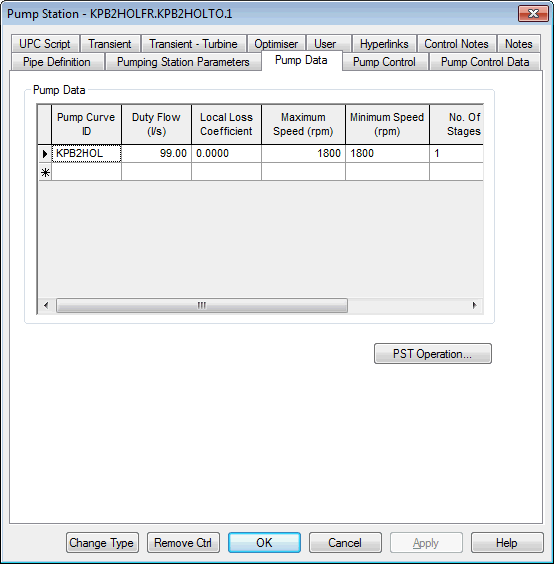Allows you to view and edit all the pump curve specific data fields for this pumping station.
The data can only be viewed and edited on this page. For more information, see the Pumping Station Data Fields topic.
Pump curve information can be viewed and edited by right clicking the row of the pump to be viewed / edited and selecting pump curve from the context menu. For more information see the Pump Curve and Pump Curve Page topics.
Pumping Station Operation can be viewed via the Pump Data Page. For more information, see Pumping Station Operation dialog.
For more information on all link types, see Links. For more on this type of link, see About pumping station.

Throttling of pumps
Each pump has a valve in its pressure pipe (outlet or To Node side) that should be fully open in operation. However, in practice, these valves are frequently used to reduce the flow through individual pumps. This applies foremost to fixed-speed units, where there is no other alternative method to control the discharge.
InfoWorks WS assumes that all units are not throttled. The user may model the throttle by inserting a valve downstream of the pumping station. However, this will apply to the Pumping Station as a whole and not to individual pumps in a station that contains more than one unit. In order to model individual pumps that are throttled, each pump should be modelled as a separate pumping station.
Local Loss Coefficient
Minor losses associated with check valves (NRVs), bends, pipe reductions, etc., may be attributed to a throttle valve as described above. Alternatively, these minor losses may be applied to each pump unit in the station by entering a Local Loss Coefficient value in the Pump Data Page.
Note: InfoWorks WS assumes an NRV at all Pumping Station links preventing backflow through the pumping station.
Cut off Level
The Cut off Level field is used to model the Net Positive Suction Head (NPSH) cut off point of each pump. This particular feature is absolutely essential when modelling real pumping stations.
If pressure at the pump inlet drops below the specified "off" level, the pump is immediately stopped regardless of its status. This is an overriding request, which cannot be ignored - otherwise pressure at the suction point will drop below that required by the type of pump. In some cases a vacuum may occur at the pump inlet, causing cavitation and/or entrainment of air. During cavitation small bubbles of vapour are formed, which grow and implode, causing damage to the pump. When the pressure at the pump inlet rises above the specified "off" level the pump will restart according to its control data.
The Net Positive Suction Head required (NPSHR) by the pump should be specified by the manufacturer. This value will be based on pump testing carried out by the manufacturer.
The Cut off Level or Net Positive Suction Head Available (NPSHA) must always be greater than the NPSHR for the pump to operate properly. As a rule of thumb, it is recommended that NPSHA is specified as NPSHR + 1m to avoid any problems at the duty point.
If there is no value input into the Cut off Level field, InfoWorks WS assumes a default value of 0.
